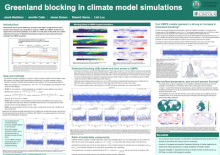Increasing Greenland blocking trend not present in climate models
Jacob
Maddison
University of Exeter, UK
Poster
Summertime atmospheric blocking over Greenland is associated with high pressure, clear skies and increased surface temperatures. Blocking events can therefore drive melting of the Greenland ice sheet, which has implications in terms of sea level rise and the global transport of heat and energy via the Atlantic meridional overturning circulation. A strongly increasing trend in Greenland blocking in the early twenty-first century has been observed but appears to be missing in current climate model simulations. Here, we analyse the temporal evolution of Greenland blocking in nearly 600 ensemble members from the CMIP6 archive and using several different blocking indices. The recent period of increased Greenland blocking is not present in any of the ensemble members considered. The maximum ten-year trend in Greenland blocking in the observations, associated with the recent increase, lies outside the distributions of ten-year Greenland blocking trends in the climate models. We demonstrate that this is unlikely due to internal variability and therefore suggests a model deficiency. By considering the ensemble mean of the CMIP6 atmosphere-only and anthropogenic aerosol single forcing experiments, which provides information on the forced climate response, the evolution of Greenland blocking is shown to be partly driven by the sea surface temperatures and/or sea ice concentrations, as well as by forcing from anthropogenic aerosols. The recent increase in Greenland blocking is potentially missing in these simulations because the model response to these forcings is too weak. Further work is required to understand why climate models cannot represent a period of increased Greenland blocking like that recently observed. Future projections of Greenland climate change may not be reliable if climate models do not represent blocking accurately enough.

Poster file
jacob-maddison-confronting-poster.pdf
(1.08 MB)
